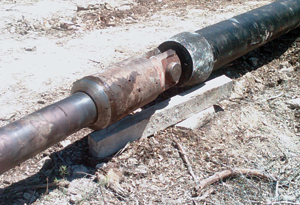Swivel with Care
 It’s well known that preventative maintenance will reduce costs in your operation — the challenge is making the time to maintain your equipment before there’s a problem. Pullback swivels for horizontal directional drilling (HDD) can be relatively easy to maintain if a simple routine is adopted on the site and in the yard.
It’s well known that preventative maintenance will reduce costs in your operation — the challenge is making the time to maintain your equipment before there’s a problem. Pullback swivels for horizontal directional drilling (HDD) can be relatively easy to maintain if a simple routine is adopted on the site and in the yard.
Preventative maintenance begins in purchasing the appropriate swivel for your rig. Swivels rely on bearings to function, and the load ratings for those bearings are not linear. Simply use a swivel at 10 percent below its working load limit and you will increase bearing life by 40 percent.
On the jobsite, the machine operators can make a huge contribution to equipment maintenance in just a few minutes by following a simple clean-up procedure:
At the end of each pull, continue rotation of the string and hose down the swivel.
Pay particular attention to the gap in the swivel. Wash all the mud and dirt from the split line groove of the swivel, until clean water runs out.
Once it’s clean, rotate the swivel a couple turns while squirting 20W machine oil into the groove to keep the seal cavity from drying out.
If fine particulates accumulate in the gap and dry out, they can cement the seals, locking them solid. Start up the rotation in a week or two, and there is a real danger that the seal will tear and be rendered useless. Torn seals are the beginning of the end for a swivel.
Once the swivel is washed clean, inspect the swivel for damage. Stubborn dirt can hide substantial damage — make sure you’re looking at base metal.
Check clevis pins for wear and be sure to check the clevis lugs around the pins for gouges or other damage. Clevis pins are designed specifically for this application and contribute to the strength of the swivel. Never substitute with unapproved parts.
Between jobs, keep the swivel clean. Protect it from the elements and keep it oiled to prevent unnecessary corrosion. Always fit a thread protector to the API threads.
Pump a little grease into the swivel to ensure the bearings remain packed. On many swivels, the grease can flow easily out through the gap between the swivel halves. On these swivels, really pump the grease through while rotating the swivel to ensure that contaminants are flushed out.
On large swivels, grease will typically exit through a relief valve — review the owner’s manual. Always make sure the valve is clear; failure of grease to exit through the relief valve may mean the valve is faulty or no longer operational. Adapters on the box connection can render the relief valve invisible. Take extra precautions if you cannot see the relief valve functioning. Do not remove the relief valve or replace with a second grease nipple.
Use only the factory recommended grease for your swivel. Mixing grease with different formulations could seriously diminish the expected properties and damage the bearings beyond repair.
Ensure that there is no loose feeling when the swivel is rotated by hand — listen for grinding sounds, which may mean the bearings have become contaminated. A well-maintained large swivel should rotate smoothly using a pry bar between the clevis ears. Checking rotation on the string can’t tell you anything: a drill rig can generate more than enough torque to rotate a worn or damaged swivel.
If the swivel is starting to hitch or grind, it must be serviced immediately. Most manufacturers offer service kits for their products; the swivel’s serial number will identify exactly which parts are required. Servicing a swivel onsite saves transportation costs, but this option should be approached with caution. Swivels are built to exacting tolerances with the appropriate tools in clean environments — don’t compromise the integrity of your equipment if you’re not prepared to do the job right.
A better option is to schedule a service visit between jobs at a factory authorized repair facility.
Assessments and repairs can be made quickly — typically in two to three weeks. You’ll get a complete inspection, good advice and a reconditioned swivel that can return to service with confidence.
Don’t risk a job on a piece of equipment that’s not functioning smoothly. Invest in a little preventative maintenance and you’ll see the benefits.
Jon Twidale, P.E., is project manager for DCD Design & Mfg. Ltd. Article was co-written with INROCK Drilling Systems.
![]()




